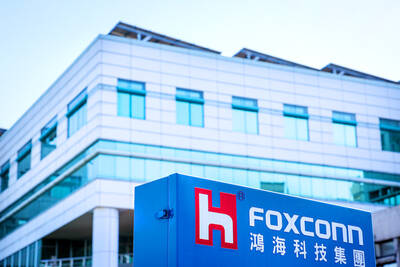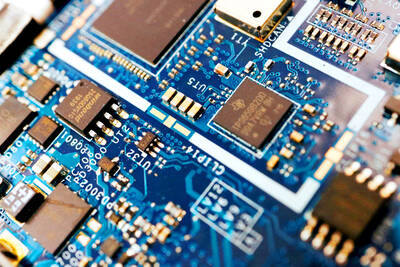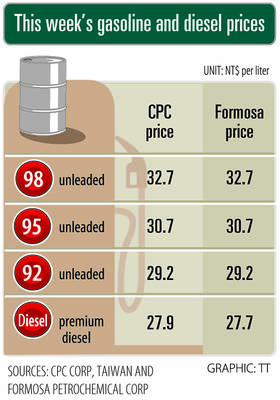SK Hynix Inc’s shares slid after record quarterly results failed to impress investors grappling with stagnant smartphone demand and questions about artificial intelligence (AI) spending this year.
Nvidia Corp’s main supplier of high-bandwidth memory reported a more than 20-fold jump in operating profit last quarter to 8.08 trillion won (US$5.6 billion) — eclipsing rival Samsung Electronics Co’s earnings for the first time.
However, the stock slid more than 2 percent after investors cashed out of a 30 percent share rally this year.

Photo: Reuters
SK Hynix’s scorching growth underscores the extent of a global boom in data center spending and the company’s place at the forefront of the high-bandwidth memory (HBM) chips that Nvidia accelerators need to train AI.
It might also help assuage concerns that an AI-fueled spending spree by big tech companies from Microsoft Corp to Meta Platforms Inc has peaked.
This week, Softbank Group Corp, OpenAI, Oracle Corp and Abu Dhabi-backed MGX unveiled a US$100 billion venture to bankroll and build data centers. News of the Stargate project, promoted by US President Donald Trump, fueled a rally in industry players from Nvidia to Arm Holdings PLC as investors anticipated a surge in data center construction.
SK Hynix said it expects HBM sales to more than double this year.
The South Korean company also boosted its annual dividend by 25 percent to 1,500 won a share.
“SK Hynix will be a big beneficiary” of Stargate, said Sanjeev Rana, an analyst at CLSA Securities Korea. “They have a significant lead, whether in terms of product quality or production yields... It will take some time for competitors to catch up.”
Well ahead of Samsung and Micron Technology Inc in designing and supplying HBM, SK Hynix said it plans to ship cutting-edge 16-layer HBM4 chips in the second half of next year.
HBM made up 40 percent of its overall DRAM chip revenue in the quarter. Demand for such high-end memory would continue to increase as investment in AI servers expands and inference — making predictions from data — grows in importance, the company said.
And while smartphone demand — even for Apple Inc’s iPhone — remains muted, the South Korean firm expects sales of PCs and devices equipped with AI features to expand, fueling a second-half pickup.
The hope is that AI demand would more than make up for weakness in traditional memory.
The company is racing to supply customers with its next HBM offering this year.
It said last year that it is investing about US$15 billion in South Korea to meet surging demand for high-end chips, on top of a plan to spend US$3.9 billion on an advanced packaging plant and research center for AI products in Indiana.
SK Hynix’s first-quarter sales could decline sequentially, yet grow strongly year-over-year. This follows robust 75 percent growth in the fourth quarter last year versus a year earlier on surging demand for HBM chips. Operating profit this quarter might also rise strongly from a year earlier.
The average selling price (ASP) for DRAM last quarter was up about 10 percent sequentially due to HBM chips, while NAND chips’ ASP was down about 5 percent sequentially.
DRAM-bit shipments this quarter could decline by about a low-teen percentage sequentially, after last quarter’s rise of about 5 percent.

Hon Hai Precision Industry Co (鴻海精密) yesterday said that its research institute has launched its first advanced artificial intelligence (AI) large language model (LLM) using traditional Chinese, with technology assistance from Nvidia Corp. Hon Hai, also known as Foxconn Technology Group (富士康科技集團), said the LLM, FoxBrain, is expected to improve its data analysis capabilities for smart manufacturing, and electric vehicle and smart city development. An LLM is a type of AI trained on vast amounts of text data and uses deep learning techniques, particularly neural networks, to process and generate language. They are essential for building and improving AI-powered servers. Nvidia provided assistance

GREAT SUCCESS: Republican Senator Todd Young expressed surprise at Trump’s comments and said he expects the administration to keep the program running US lawmakers who helped secure billions of dollars in subsidies for domestic semiconductor manufacturing rejected US President Donald Trump’s call to revoke the 2022 CHIPS and Science Act, signaling that any repeal effort in the US Congress would fall short. US Senate Minority Leader Chuck Schumer, who negotiated the law, on Wednesday said that Trump’s demand would fail, while a top Republican proponent, US Senator Todd Young, expressed surprise at the president’s comments and said he expects the administration to keep the program running. The CHIPS Act is “essential for America leading the world in tech, leading the world in AI [artificial

DOMESTIC SUPPLY: The probe comes as Donald Trump has called for the repeal of the US$52.7 billion CHIPS and Science Act, which the US Congress passed in 2022 The Office of the US Trade Representative is to hold a hearing tomorrow into older Chinese-made “legacy” semiconductors that could heap more US tariffs on chips from China that power everyday goods from cars to washing machines to telecoms equipment. The probe, which began during former US president Joe Biden’s tenure in December last year, aims to protect US and other semiconductor producers from China’s massive state-driven buildup of domestic chip supply. A 50 percent US tariff on Chinese semiconductors began on Jan. 1. Legacy chips use older manufacturing processes introduced more than a decade ago and are often far simpler than

Gasoline and diesel prices this week are to decrease NT$0.5 and NT$1 per liter respectively as international crude prices continued to fall last week, CPC Corp, Taiwan (CPC, 台灣中油) and Formosa Petrochemical Corp (台塑石化) said yesterday. Effective today, gasoline prices at CPC and Formosa stations are to decrease to NT$29.2, NT$30.7 and NT$32.7 per liter for 92, 95 and 98-octane unleaded gasoline respectively, while premium diesel is to cost NT$27.9 per liter at CPC stations and NT$27.7 at Formosa pumps, the companies said in separate statements. Global crude oil prices dropped last week after the eight OPEC+ members said they would